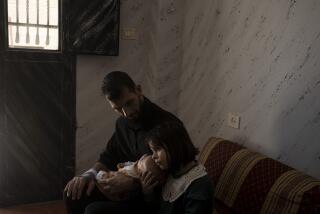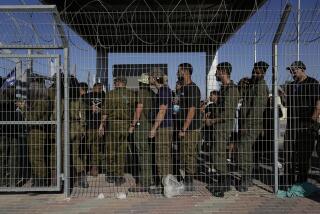1996 prison massacre a spark in Libyan revolution
Reporting from Benghazi, Libya — Every month for nearly 10 years, Ezzedin abu Azza’s family traveled to the gates of Abu Salim prison in Tripoli to deliver a package of clothes, food and medicine, not knowing whether it ever reached him.
They hadn’t seen him since the day in 1993 when the 23-year-old was taken away for questioning by state security agents. But still they made their journey from Benghazi every month.
Then, in 2002, the family was told he had died, six years earlier.
Photos: A journey from Libya back to Egypt
Here in this eastern city that has long simmered with resentment over the brutal rule of Moammar Kadafi, the Abu Azzas were among the lucky ones. Other families would wait another six years, or longer, to hear that their loved ones were among a reported 1,200 political prisoners at Abu Salim who were killed, in a matter of hours, in June 1996 as they fought for better living conditions and the right to see their families.
Other families have never been officially informed and only assume that their loved ones are among the dead.
When the government in 2008 began notifying many of the families of the deaths, they set up mourning tents and posted obituaries.
“We were notified 12 years after his death,” many obituaries read, brashly pointing an accusatory finger at the government.
Now, a decade and a half after the massacre, the prisoners’ stories and an unprecedented call for justice by their families helped spark a revolution.
*
When state security officials took Ezzedin abu Azza, a self-employed electrician, they said they wanted to speak with him for “10 minutes,” his brother Imran abu Azza recounted. The family later learned that officials had accused him of knowing about an opposition group and not reporting it. Two days later, he was transferred to Abu Salim prison.
In 1995, a released prisoner sneaked out a letter from Abu Azza written on a piece of torn fabric. He said he was doing well and expected to be released soon because he hadn’t done anything wrong. He asked for a photo of his mother, suggesting that his family hide it inside a food carton.
Another prisoner told the family that Abu Azza kept an empty cheese box bearing the brand name Hawa, his mother’s name. He would hold it and stare at it for hours.
Then, in 2002, the family suddenly was given his death certificate. It listed no cause of death and made no mention of the prison, only Tripoli, the city where he died.
Like that of other prisoners, his body was never returned.
Kadafi has acknowledged mass killings at the prison, but has never answered calls for accountability.
Demanding justice and a proper burial for the dead, the families in 2008 filed a lawsuit against the government and began to hold protests every Saturday in front of the Benghazi courthouse, boldly holding up banners with photos of the prisoners, an unprecedented act in Libya.
The arrest last month of their attorney, Fathi Terbil, and the subsequent demands for his release have been credited with helping turn Feb. 17 — which had been designated by activists as a day of protest — into the date that now marks the start of the Libyan uprising.
After initial rebel victories in much of eastern Libya, Kadafi’s better-equipped forces regained control of many of the rebel-held cities and began attacks on Benghazi. The regime then declared a cease-fire after the United Nations Security Council voted to authorize international military action.
No matter how the uprising ends, many believe the role of Abu Salim extends beyond Terbil’s arrest and that the courage to rebel came, at least in part, from the daring shown in the families’ early demonstrations in Benghazi.
“When the families of the Abu Salim martyrs protested, it broke the barrier of fear, slowly, slowly. That’s what gave people the courage,” said Imran abu Azza. “Before that, this word ‘protest’ was not in the dictionary of the Libyan people.”
“The revolution … rose from under the mothers and fathers of Abu Salim,” said Ali Gaooda, whose brother was among those slain. “It is as a result of the mothers’ stand.” His brother, Bin Issa, an imam, was imprisoned when he refused to deliver sermons given to him by government agents.
The government did not officially bar the earlier protests, dominated by grieving elderly parents. But some people were detained and warned against further demonstrations or bribed to keep quiet and drop their cases.
Rafah Gaooda, another brother of Bin Issa, was detained for four days as the protests were just beginning. His interrogator told him bluntly, “Don’t stand in the street.”
“They were forbidden to even mention this word [protest]; it was banned by law,” said Abdul Matlub A. Tobuli, a professor of comparative literature at Garyounis University in Benghazi. “The families kept on because they felt it’s a disaster that needs to be brought to justice.”
Out of fear, some Libyans avoided the courthouse during the early years of the protests. Many had a vague idea about the prison massacre, but few outside the families knew the details, or had the courage to ask.
Though Tobuli knew about the killings, he said he was shocked after last month’s uprising when he saw how many faces there were on the courthouse banners and understood the breadth of the massacre.
“Now because of the uprising people are learning for the first time, ‘Oh my God, all this happened on the same day,’” he said.
Much of what is known about the Abu Salim killings comes from a former inmate, Hussein Shafai, who worked in the prison’s kitchen and was interviewed by Human Rights Watch in 2004 and 2006.
Shafai told Human Rights Watch that a group of prisoners had taken two guards hostage to press their demands for family visits, better living conditions and court hearings on their cases. tGuards fired on prisoners in open areas, injuring more than 100, by Shafai’s estimate.
After senior officials arrived, prisoners agreed to return to their cells and release the hostage guards (one of whom had died) in return for negotiations. But on the morning of June 29, most of the inmates were herded into several courtyards.
At 11 a.m., someone with the government’s special forces threw a grenade into one of the courtyards; then came more than two hours of continuous shooting by forces on the prison rooftops.
Shafai estimated that 1,200 were killed by counting the number of meals he was told to prepare before and after the massacre. Libyan officials have since given similar figures. Those who survived were mostly low-security inmates and others who had been kept inside.
Stories of the prison and the families are being told and retold in Benghazi, a symbol of a newfound, and possibly short-lived, freedom of speech in a city that has been the epicenter of the revolution. Each day, families gather at the wall of photos and share their stories.
“There are still people who don’t know. We would go to the courthouse and people would be standing in front of the photos and look at them with surprise at the number,” said Yousef abu Azza, another of Ezzedin’s brothers. “Now, with the freedom, they can express their sympathy.”
Among the photos on the wall is one of Ezzedin, with a mop of black hair and a light fuzz above his lips.
But in his 67-year-old mother’s home, such photos are hidden. Ever since the family was notified of his death, Hawa’s other children have insisted on it. Even now, they say, their mother cannot see a photo without being overcome with grief.
Like Ezzedin staring at the Hawa cheese box, the photos are a reminder of what she once had. Only for her, they are no comfort.
Photos: A journey from Libya back to Egypt
More to Read
Sign up for Essential California
The most important California stories and recommendations in your inbox every morning.
You may occasionally receive promotional content from the Los Angeles Times.











